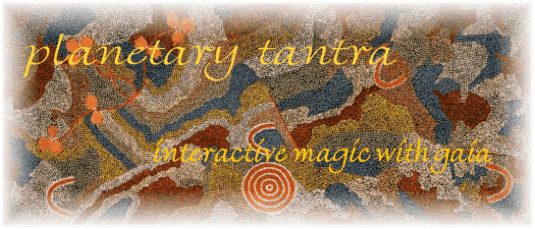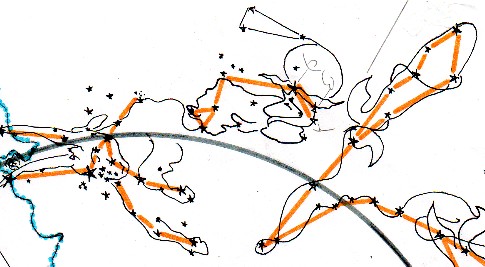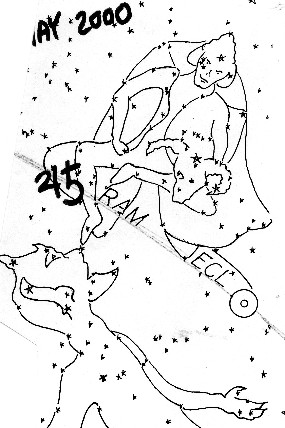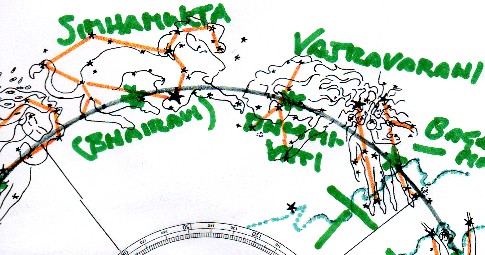| Site Guide |
| Tantra Tour |
| Gaian Tantra Vow |
| Foundations |
| SHAKTI CLUSTER | Dakini Calendar |
| Terma | Sierra de Libar |
The Tantric Conversion, II
The Shakti Cluster and the Tantric Zodiac
I am splitting the description of how I discovered the Shakti Cluster into two parts. Initially, I understood the Cluster to consist of ten components, the Mahavidyas of Hindu religion, following what scholars say. This is received material. In part two of The Tantric conversion, I will explain the advance from ten to eighteen components: that is to say, how I modified the received material into an expanded view of the Cluster. A related essay, Trance Learning, explains the experimental method (shamanic technique, if you will) that I use to engage the Shakti Cluster.
Shri Vidya Complex
I did not derive my view of the Shakti Cluster from books and studies. Rather, it began to emerge spontaneously in my shamanic practice during the summer of 2008. The groundwork had been laid years before in my involvement with the supernatural guardian I call DMD, "Devi My Dakini." My first encounter with this entity occurred in a lucid dream at the age of four. She appeared to me as a terrifying hag, similar to the famous vision of the Indian sage Naropa (1016 - 1100 CE). Herbert V. Guenther, whose 1963 book The Life and Teachings of Naropa is a modern classic, identified the witch of Naropa's vision with Dorje Phagmo, the Daimond Sow or Adamantine Sow of Tibetan Buddhism. Her name in Sanskrit is Vajravarahi. She is one of the more prominant dakinis of Buddhist Tantra. Guenther compares her to the Jungian anima, the numinous female component of the male psyche.
Below: Tibetan thangka, typical image of Dorje Phagmo. This dakini is of high status, considered to be a Female Buddha. Her dancing power is iconic, repeated in almost all dakini images. Like Kali, she wears a garland of severed heads. In her right hand she holds a knife used for cutting away illusions, including the illusion of separate ego identity. With the dorje handle of the blade, using the butt, she shatters all mirrors of subjectivity. In her left arm she cradles a magic staff adorned with banners. In her left hand she holds a skull-cup filled with blood—hence the term, blood-drinking dakini. The five-skull crown signifies the Tantric principle of transmutation of the poisons of the five emotions (variously named): anger, jealousy, greed, hatred, and obtusity or denial. The dakini drinks these emotions ecstatically, for to her they are taste delicious and converts them into wisdom nectars.
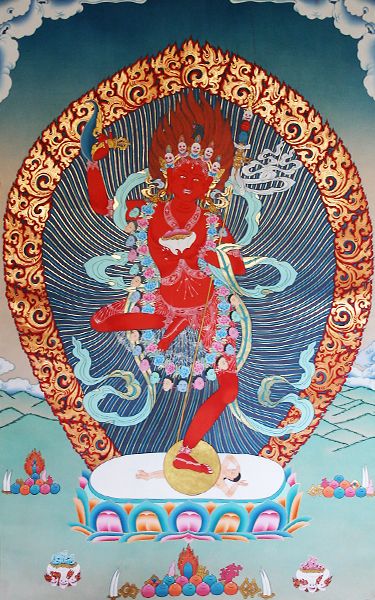
Such visionary encounters are common in Tibetan Buddhist lore. The dakini who so appears is a tutelary deity, a supernatural agent who guides and instructs. Almost always, the person who has the vision, if not someone commenting on it, will identify the supernatural agent by name. In shamanic encounters with the Otherworld, it's good practice to know exactly who's on your case. In one of the initial rites of Kala Tantra, the individual identifies a specific spiritual guardian with whom she or he maintains a steady long-term alliance. My guardian appeared to me vividly when I was four, but it was not until fifty years later that I learned to identify her and place her in a cosmic setting. Through experiments with and without the aid of psychoactive plants, I was led to understand that DMD is the Paramita ("supreme one") of an array of female divinities identified in Hindu religion as the Shri Vidya Complex.
Shri is an honorific title meaning "sublime, glorious." Shri Vidya is "Glorious Wisdom." Once again, the word wisdom proves to be the guiding motif. All my work with the Gnostic Sophia was the outgrowth of my inner connection with Hindu goddess religion centered on the Shri Vidya Complex. I made the Hindu connection in Southern India at nineteen, years before I delved into Gnosticism. I did not have to grasp this connection intellectually for it to be effective, but eventually I did conceptualize it. Over many years, I did not directly associate the Gnostic Sophia with the Vidya goddesses, but I was certainly guided in my Gnostic studies by my guardian, she who holds a paramount role (paramita) among those sublime deities.
There are 90 million Shri Vidya divinities, all female—so I learned by sacred instruction beneath the Devi Tree on Infinity Ridge. I call them by the Sanskrit name dakini, "sky dancer," because they operate in the sky, in the atmosphere of the earth and, by extension, in the starry regions. Of these 90 million, a group of 10 million are intimately associated with the central star of our solar system, Savitra, and within this 10 million is a sub-set of dakinis who are aligned in a particular way to Kali: the Kalika Dakinis. Kalika is the adjectival form of Kali; hence, Kaliesque or relating to Kali.
Over time, I understood that my guardian DMD is the Paramita of the Kalika Dakinis of the Savitra array of the Shri Vidya Complex. Thus she is a dominant Kaliesque deity. It could be said that Devi My Dakini focalizes Kali in a subtle and particular manner. She appears to be in the class of the blood-drinking Dakinis of Tibetan Buddhist Tantra. For occult reasons, I am not permitted to know or pronounce her name. She is not Dorje Phagmo, I can tell you that.
Dakini is a word of obscure origin, loaned into Sanskrit from an unidentified source. It may derive from the Dravidian cultures of Southern India, ancient stronghold of goddess worship. The Tibetan word for dakini is khandroma, "sky dancer." In the accelerated learning I have experienced since July, I have come to regard the Mahavidyas as dakinis, so I now lump them into the lot with Tibetan figures such as Vajravarahi. For some years, I have had a general sense of the Kalika Dakinis, simply because DMD, who is on my case, leads the pack. Quite rapidly, through the summer of 2008, I recognized the specific names and actions of these supernatural witches. You have to be there to see how this kind of recognition emerges... I would compare it to the way a painter sees a canvas evolve from colors and indefinite forms, with distinct figures taking shape as the entire composition emerges, all by itself. The process is the same in any creative activity, be it writing a novel or composing music. (For more specifics on this experience, see Trance Learning.)
Hindu Earth Goddesses
You may wonder, If dakinis are celestial deities who dance in the sky, what do they have to do with the solid earth? Well, Gaia herself is a great dakini who dances through the sky. Yet she provides a firm foundation for sentient life, and the basis for enlightenment as well; hence the name Sthavara, "stable one," for the goddess who supported and witnessed the enlightenment of Shakyamuni.
In Buddhist Goddess of India, Miranda Shaw covers a range of Gaian deities from Asian tradition, starting with the Vedic goddess of the earth, Prthivi (pronounced PRI thi VEE). This name for mother earth means "vast one." Hence, PRTHIVI = GAIA, another Greek-Sanskrit correlation.
In part one of The Tantric conversion, I used the concept of the belly-button or navel to describe the tight whorl of the Shakti Cluster. The Sanskrit word for navel is nabhi. Buddhist writings compare the navel of the world, prthivi-nabhi, to the seat of wisdom where the Buddha sits, bodhi-manda. The navel or hub is the still point of the spinning world. This still point is both the axis of the planet, astronomically, and the axis of enlightenment. Commentaries on the enlightenment of Shakyamuni such as the Buddhacarita assert that the stability of the world-navel alone makes it possible for the mind to be steadied and concentrated for ultimate awakening. Enlightenment depends on the wisdom goddess, Sophia, embodied in the living planet, Gaia. There is nothing remote from earth or other-worldly about the ultimate state of awakening in which mind spontaneously recognizes and reverts to its own nature, the non-originated state of pure beholding. Liberation is not escapism, not a flight from the sensory world. It is clear and steady centering in this world of sentient life and sensory impressions. Total recognition of this world as all there is, is nirvana.
To show the total dependence of Buddhist philosophy on the mystique of the earth goddess, Miranda Shaw considers Prajnaparamita the supreme wisdom goddess of luminous discernment, Parnashavari the leafy plant goddess, Marici the sunrise goddess, Janguli the snake goddess, Sarasvati the divine muse, Vasudhara the bountiful lady, Cunda or saving grace, Sitatapatra the invincible goddess, Usnisavijaya the bestower of long life, and Tara the one who delivers or saves. She concludes with a close look at five Tantric Female Buddhas: Vajrayogini, Nairatmya, Chinnamunda, Simhamuka and Kurukulla.
This fall when I came across Shaw's book, I was already engaged in forming a visionary synthesis of the Mahavidyas, but doing so, I found myself pulling in a few more goddesses from here and there. Initially, I had no fixed number in mind, but I had a clear hunch that ten was not the full deck. Among the Hindu deities Shaw considers is one of the Mahavidyas, Chinnamunda, also called Cinnamasta. She is noted for the remarkable feat of severing her own head and letting the blood that spurts from her neck be drunk by two attendant goddesses.
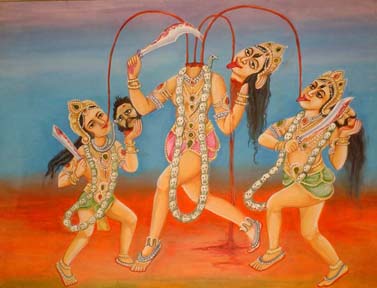
Again, this is not an image that is going to charm everone who comes down the block. Cinnamasta is one of the more gruesome Mahavidyas. Her head-severing act represents the attainment of egoless awareness and immersion in the potent knowledge that courses in the bloodstream, iron-bound thunderbolt wisdom. The blood surges in three streams to represent the three inner channels of subtle anatomy, right, left, and center.
Some folks may not go for Cinnamasta, but I know one person who certainly did: Joseph Campbell. When I saw him lecture at the Saint Francis auditorium just off the plaza in Santa Fe, the place was packed, with people stading three deep along the wall. Campbell's eyes gleamed as he spoke at length of the subtle anatomy of the chakras, and their corresponding states of awakening, especially relishing the image of Cinnamasta. I recalled Campbell's riveting talk this fall as I contemplated the expansion of the Shakti Cluster into a dazzling coven of blood-drinking dakinis. I rapidly verged toward the moment when the Mahavidyas would morph and be absorbed into a larger array of what I now call Gaian Dakinis.
Shapeshifting Zodiac
Cinnamasta was a breakthrough because she linked the Hindu Mahavidyas to Buddhist Tantric lore on subtle anatomy. She also brought up an image from the Zodiac, an odd mutation spontaneously produced by my imagination years ago, which I had never quite been able to place in my mythological studies. It involves a way to visualize the constellation of Aries, the Ram. Be reminded that I refer here to the observable, real-sky constellations, not the invisible signs. The Ram is not to be identified with the astrological sign Aries.
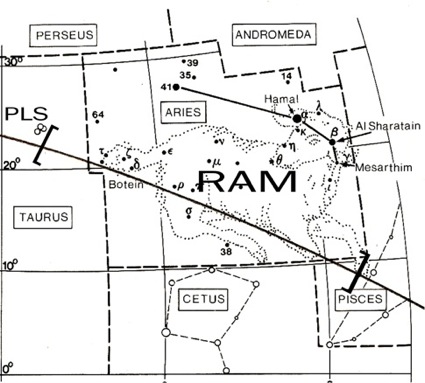
The Ram is a diminutive constellation situated almost entirely above the eclilptic, the apparant path of the sun (Ill. J. Stahl, New Patterns in the Skies).The three brightest stars mark its horns and head. Below the Ram is a large, sprawling constellation called Cetus, the Sea Monster. This is a vast devouring critter, a kind of Ahrimanic demon to use a Steinerian trope.
In my way of drawing the Ram, I put a kind of aura over its head and associated it's head-stars with a neighboring constellation called Triangulum, an isoceles triangle to the left (east) of the Ram composite. Why did I do this? It's hard to say. Such impressions arise from continuous skywatching and poring over sidereal mythology... It's the creative imagination at work, sorting, selecting, arranging, and extrapolating the material one supplies to it. Imagination is the sorcerer's apprentice.
Eventually, I tried a modification of the Ram in which I represented that figure like a Bodhisatta, incorporating Triangulum and other stars in the region directly above the classical composite. This modification represented the interactivity of celestial images that comes up so often and so strikingly in skywatching. The Bodhisattva is poised majestically above Cetus, the Ahrimanic threat or satanic jester, comparable to Mara, the lord of illusion who taunted Shakyamuni at the moment of his awakening. I imagined the Bodhisattva to stand for liberated awareness that not only frees us from the mental fictions of Cetus/Ahriman/Mara, but also may free the monster itself -- hence I portrayed him with a pleading gesture.
This draft of the metamorphosed Ram with the pleading Ahriman was drawn for a specific moment: the conjunction of jupiter and saturn at the feet of the Ram in May, 2000.
Considering the self-beheading Mahavidya Cinnamasta, I was reminded of the way I had placed the severed head of the Ram in the lap of the Bodhisattva, without any intellectual notion of why I did so. The conceptual association, if you want to go into it, would run something like this: bodhi, the awakened mind, severs the ego consciousness and defeats or dissipates the illusions of Mara, the samsaric mind. This proposition is close to the received interpretation of Cinnamasta as a representation of egoless awakening.
With the Ram/Bodhisattva image brewing in my mind, I began to sense how the other Mahavidyas might fall into order around the Zodiac, encompassing the entire array of thirteen constellations. However, I had no intention to sit down with pen in hand and run off those correlations, as if it were merely a matter of mix and match. Truth be told, correlations of this kind arise by the process of free association, letting the subconscious work by itself, but I have learned to restrain the process in order to get better results. In other words, correlation of this kind is not a mental exercise that can be executed rationally, it is a subliminal experiment better left to run its course. So, I did not allow myself to contrive a set of possible correlations between the Mahavidyas and the constellations of the Zodiac. Instead, I delegated the task to my subliminal mind and let the matter float without conceptual interference for a few days.
What come out of my subliminal brooding was a provisional set of correlations that I then proceeded to confirm by sessions of shamanic trance in parallel with more comparative studies in sidereal mythology. What a job description! No wonder I can't find a slot in the workplace.
Cinnamasta obviously fell into the Ram position, with a soft clunk. But there are thirteen constellations and only ten Mahavidyas. I knew initially there would be no point-by-point match. Anyway, I strongly sensed that the ten-element Shakti Cluster had to expand. But how? And who else would be included?
The Mahamudra Sky
To describe what came next, I need to relate something that happened at the end of July, the week following my experience of the blue sky heart emptiness in Ronda, the culmination of the 108-day initiation. Enlightenment builds. In the days immediately after I sent off the black box offering to Emma, I found that what I experienced in Ronda did not fade out: it just kept happening to me. I was in a steady-state of wisdom-filled bliss, exceptionally open to everything. Little did I know that my life-long observations of the night sky would be transformed in this sublime mood of heartfelt emptiness.
The new moon fell on August first in 11 Leo (Sign), putting it in the constellation of the Crab. The last four days of July would be the time to perform a sunrise crescent divination, the most precise and penetrating method of divining the skies. It involves careful observation of the lunar crescent that rises before dawn. It takes four days, optimally with four hours of sky-gazing each evening in the darkness before dawn. At the final observation on the dawn of the fourth day, the crescent is a mere sliver that dissolves into the light of the rising sun. The divination culminates with close observation of how the crescent rises in the immediate setting of nature, the background stars, the horizon, trees, clouds, passing birds, any and all local conditions. All these factors merge at a certain, unpredictable moment to produce the fruit of the divination—the precise answer to a specific question.
I won't specify what I asked at that particular divination. It was about the fate of someone I know and love, an intimate personal matter. To get the desired result, I performed an owlfeather divination. This is a ritual using an owlfeather held in the right hand to focus the mind on silent knowing and inscribe on the body the incoming emanations that define the divined response to the question posed. This "inscription" is made by flicking the nub of the feather, the part that would be used for writing were it dipped in ink, on the ball of the thumb of the right hand.
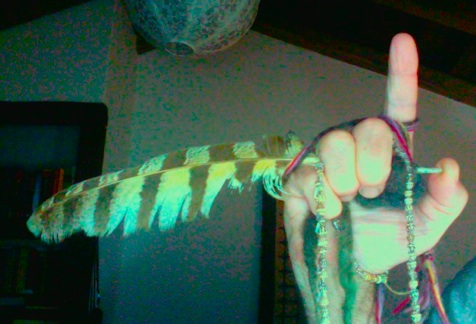
The sunrise crescent divination with an owlfeather proved to be quite an intense experience. And so beautiful, given that I was bestowed with magnificent skies all evenings. Four shifts of four hours of uninterrupted sky-gazing in total silence has a cumulative effect that can produce some remarkable perceptions. Midway through the second evening, I noticed something extremely odd. Before my eyes, something was happening to the way I visualized the constellations. This effect has nothing to do with the ritualized concentration required for the owlfeather divination. It just happened as I scanned the celestial dome. Returning again and again to familiar constellations in the zodiac, such as the Fishes, Ram, and Bull, as well as to extra-zodiacal figures like Cassiopeia and Auriga, I found them morphing strangely. For over forty years I have been habituated to picturing the constellations primarily after their Greco-Latin identities. For intance, I would view Perseus in terms of the composite described by Greco-Latin astronomy and in the visual imagery of Greco-Latin myth: the crouched warrior brandishing a sword to cut off the head of Medusa. The same for Cassiopeia, Auriga, the Bull, the Ram, and the entire panorama of starry actors.
But now, deeply immersed in the owlfeather divination, I found these long-familar images dissolving before my eyes. Looking at the Ram, for instance, I did not see the usual image pictured in the above illustrations. The composite stars of that constellation seemed to dissolve before my eyes, or the stars were as if oddly displaced, like letters in an alphabet soups slowly re-arranging themselves. This was a non-conceptual process witnessed in silent knowing, mental radio turned off. And all the more vivid for being so. I found that I was being shown a whole new way to view the night skies. The Greco-Latin images dissipated and in their place emerged great looming animal shapes, demonic faces, ritual objects. Above the Ram emerged the head of a deer, the graceful spread of its antlers adorned in bluish light. A name came to mind: Mystic Blue Deer. I recalled the blue deer of Huichol myth. I glimpsed a buffalo-headed demon that I recognized as a heruka, a wrathful male diety of Buddhist Tantra. In the region of Auriga, the Charioteer, saw a jeweled mask of Shiva that shifted into the darkly radiant face of his Greek counterpart, Dionysos. In the place of the Pleiades, I beheld a spindle. Stretching from the Fishes to Aurigahovered a huge vulture with wings outspread in a majestic gesture of shelter.
I was witnessing the spontaneous revelation of the Mahamudra Sky, magical images of blissful emptiness. This revelation came to me all on its own, with no mental contrivance of any kind. If I attempted to think out the emergent figures, the process faltered. Into the fourth evening, I realized I was undergoing a kind of overwrite of all my previous skywatching skills, so that a totally new order of perception could be installed. The process was effortless and without stress, extremely pleasant. As I brought rational understanding to bear on this immense imaginative makeover, I concluded that I was being shown the sky as seen by Bon Po diviners of pre-Buddhist Tibet—that is, the sky of indigenous visionary trance.
Gaian Dakinis
So, I received the vision of the Mahamudra Sky almost as if it were a side-effect of the owlfeather divination. Yet what a momentous shift it was for me! Almost immediately, I began to apply the animations of the newly revealed panorama to my contemplations of the Shakti Cluster. In this metamorphosed view, some but not all of the Mahavidyas assumed their places around the Zodiac, and others assigned themselves to extra-zodiacal regions. Where there was no point-by-point correlation between Mahavidya and constellation, other female deities entered the scenario. They just showed up, fresh from an all-night rave at the Vajrayana Club, dancing rapturously and delighted to be included in the new and expanded configuration of the Cluster.
Over a few weeks, I developed a provisional array of dakinis matched to the thirteen constellations, plus half a dozen more that did not. I was gradually arriving at a novel configuration of ten Hindu Mahavidyas with other female deities drawn from Buddhist Tantra. The overall picture of correlations was irregular and anomalous, which I found pleasing. The magic number, so it appeared, was going to be eighteen. I decided to call the entire group Gaian Dakinis. Why? I had an intuitive flash that the Shakti Cluster, expanded in this manner, was leading me to a revelation about Gaia—something to do with the plot of her lucid dream. The owlfeather ritual triggered the opportunity to re-envision the entire celestial globe with indigenous graphics: the Mahamudra Sky. At the same time, I was drawn to convert the habitual Greco-Latin constellations, Ram, Bull, Twins, etc., into female tutelary deities from Tibetan and Indian religion: the Tantric Zodiac.
Why would Tibetan and Indian Tantric imagery give an imaginative rendering of what's happening to Gaia in her lucid dream? Well, first of all because this imagery is intrinsically derived from religions of the goddess! I would expect that the goddess sees herself in the imagery of the religous imagination in which she has been sought for millenia. In any case, that is the best chance, if not the only chance, for humans to imagine how Gaia's dream-life operates from her own perspective, inside it. My shamanic practice in communication with Gaia has convinced me that she reaches us through the imagery we use to reach her, but not through all of it. We cannot reach the planetary goddess, for instance, through the imagery of the Virgin Mary or the Divine Sophia of Greek Orthodoxy. I am quite aware that this outrageous statement will infuriate some folks. It will be deemed totally unacceptable to claim that some imaginative approaches to the Divine Feminine are better than others. But I do say so. Most emphatically.
Religious scholars, including feminists such as Rosemary Radford Reuther (Goddesses of the Divine Feminine), tend to play the game of syncretism, finding valid allusions to the Divine Feminine in diverse religions and cultures. New Age mystics such as Caitlin Mathews (Sophia, Goddess of Wisdom) make it look like any vision of the Goddess is as valid as any other, given that the devotion of the heart is pure. Even venerable Buddhist scholars such as Thomas Cleary (Twilight Goddesses, written with Sartaz Aziz), do not play favorites among the goddess figures and female buddhas drawn from various cultures. It's all the same to them: people of different faiths and cultures who use religious imagination to reach the Goddess are all going to get equally valid results. But will they?
When it comes to religious imagination, I feel compelled to ask, How do we know how well anyone is using this tremendous capacity? And how can we tell if are they succeeding with it? How do you measure success (read: truth) in the use of religious imagination? The above scholars don't bother to pose such a question. I draw a strong distinction between religious imagination that produces a fictional icon of the Goddess, and that which enables direct access to Her, experientially rather than through the blind man's bluff of faith. Faith is the booby prize of religious imagination. You do not get a direct line to the planetary mind via the Virgin Mary, even with the help of Wine and Host. You do get a genuine planetary connection of the Divine Feminine with Dorje Phagmo and her chorus line of naked blood-drinking dakinis. With the Shakti Cluster comes the full-bore connection, eighteen channels at once.
Here is my claim: the Gaian Dakinis of the Shakti Cluster, eighteen strong, are channels into the lucid dream of the planet, or eruptions from the dream, either way. In their totality, these eighteen female deities comprise the identity of the planetary goddess as she experiences herself in her waking dream—that is, as she awakens lucidly to conative awareness of her dreambody, earth.
The noun identity has no adjectival form that would mean "of, or pertaining to, identity." I might propose the adjective idential (I-DEN-chul): for instance, your driver's license is an identity document, telling the authorities who you are. This works pretty well, but to keep it simple let's use the word identity as an adjective or compound noun. For example, your family history is an identity narrative, telling you who you are in geneological terms, etc. The historical chronicles of a nation make up the identity legend of its natives, the basis of their agreed collective identity. The Gnostic story of the Anthropos is an identity myth for the human species, telling us who we are in cosmic terms.
Here again is my claim, using the word identity as just demonstrated:
The Shakti Cluster is the identity node in the lucid dream of Gaia, the imaginative configuration through which she comes to recognize herself and act deliberately in her waking dream, and through which we, in turn, can participate in her dream.
Gaian Dakinis are so-called because, quite simply, they are aspects of Gaia, the planetary entelechy. Put otherwise, they are channels of her identity node. I use the word node provisionally, for lack of a better term. Wikipedia says:
In communication networks, a node (Latin nodus, ‘knot’) is an active electronic device that is attached to a network, and is capable of sending, receiving, or forwarding information over a communications channel. A node is a connection point, either a redistribution point or a communication endpoint (some terminal equipment).
As channels in the identity node of Gaia, the Dakinis of the Shakti Cluster are part of a communication network that opoerates both from Gaia to humanity, and vice versa, from humanity to Gaia. Within the lucid dream of Gaia, the planetary mind has configured itself into an eighteen-channel console, a medium for two-way communication. The Dakinis of the Shakti Cluster are specific figurations of Gaia's imagination of herself as the main actor in her lucid dream. Not all dakinis play this role. Gaia awakens in her dream by seeing herself reflected in these eighteen facets. But we also can recognize, and engage, the living intelligence of the planet through the same facets.
The Dakini configuration that enables Gaia to awaken in her lucid dream also enables us to participate in her awakening.
Such is the wild and outrageous, unparalleled and unprecedented opportunity presented by the Shakti Cluster—IF you go interactive with it.
Detail of initial sketch of the configuration of Gaian Shaktis
in the Tantric Zodiac
jll October 2008
More in this vein in the forthcoming essay, Dakini Dance: Interaction with the Shakti Cluster.
jll: 27 November 2008 Andalucia

